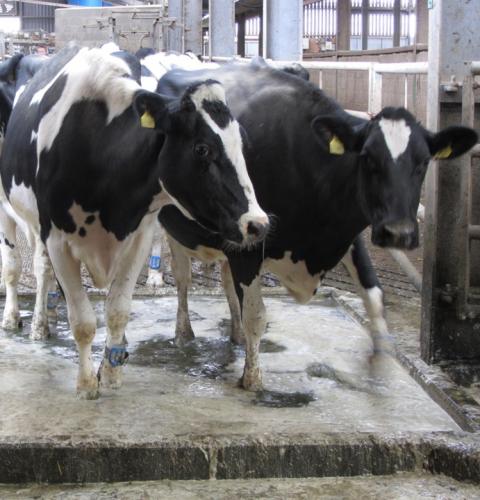Cow mobility is one of the most important factors in herd health, with lameness the most significant welfare issue affecting the dairy cow. Lameness cases can be costly and also impact on milk yield and fertility, so good hoof health protocols can help improve productivity and profitability.
At a Farming Connect event in Usk, vet Sara Pedersen, a specialist in cattle health, outlined the main issues affecting mobility in dairy herds and discussed best practice when dealing with lameness cases.
“We need to assess what the levels of lameness are in a herd, what’s causing it and target the relevant risk factors,” she said.
Sole ulcers, white line disease and digital dermatitis account for 90% of problems on dairy farms and are responsible for a range of direct and hidden costs:
|
|
Average cost per case |
Reduction in yield (litres) |
Extended calving interval (days) |
Increased risk of culling |
|
Sole ulcers |
£520 |
574 |
40 |
56% |
|
White line disease |
£300 |
369 |
30 |
11% |
A case of Digital Dermatitis costs an average of £75 and the calving interval is extended by 20 days, and if heifers contract it more than once before their first calving it can have a significant impact.
“The conception rate at first service drops by 13.3% and they take 24 days longer to get in calf, at a cost of £5 per day to keep a heifer on farm,” added Sara. “They also on average give 335 litres less in their first lactation and are three times more likely to get digital dermatitis again, so the cost impact is massive - digital dermatitis control must start with heifers.”
Maintaining low infection pressures on farm through good hygiene, slurry management and foot bathing cows will help keep bacteria away from the feet that can cause digital dermatitis and foul in the foot.
Good horn quality and hoof shape will strengthen weight-bearing capabilities and reduce the risk of sole ulcers and white line disease. Sole ulcers are more likely to develop if cow comfort is poor. If cow flow is an issue on farm, white line disease can be more prevalent, as the ‘white line’ - which joins the sole to the side walls of the hoof - is prone to shearing forces.
“With white line disease I’m always looking at forces on the feet, so how are we herding the cows in? Are quad bikes or dogs pushing the cows to walk quicker? Are the cows pivoting or turning sharply around the parlour, are there slippery surfaces in the collecting yard?” said Sara. “If a backing gate is used too aggressively cows bunch up and this puts more pressure on the feet as they have to force their way through to the group. The feed face is also a risk factor as cows do lots of pushing and shoving – particularly if there isn’t enough feed space per cow or the design is incorrect.”
Sole ulcers can be a particular issue as a result of changes in the foot at calving. The horn produced is of poorer quality, the ligaments slacken off and there are changes in the fat pad leading to reduced stability and support of bones in the foot. Good hoof management during the dry period is therefore essential to helping prevent mobility issues around calving.
“Trimming as cows are dried off is really important, as is making sure the cows are really comfortable and off their feet, because when the foot isn’t as stable you don’t want her putting loads of pressure on it,” said Sara. “At drying off the aim is to stabilise the feet and balance weight bearing, shifting weight to the stronger outside wall of the claw to reduce the risk of problems.”
Sara also emphasised the importance of mobility scoring and being aware of small changes in movement.
“When you’re mobility scoring it’s better to score harder because the harsher you are the better the results. Also try to look at everything as if it’s the first time you’ve seen the animal because changes can be so subtle from day to day. The sooner we treat cows, the sooner they’re going to get better.”

